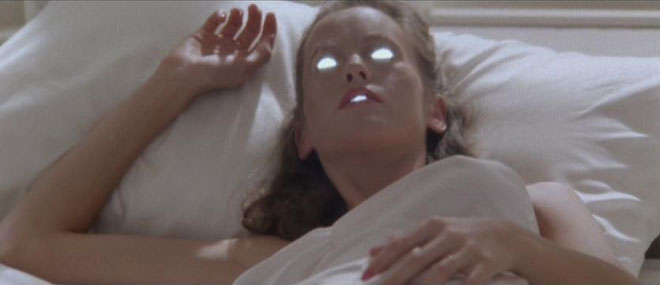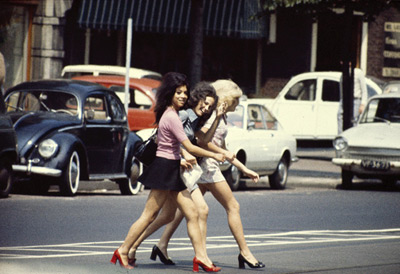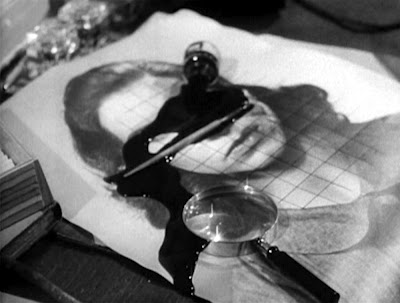faces
‘If it moves, sponsor it. If it doesn’t, paint it red.’ –Coca-Cola
People often reveal their private emotions in tiny, fleeting facial expressions, visible only to a best friend — or to a skilled poker player. Now, computer software is using frame-by-frame video analysis to read subtle muscular changes that flash across our faces in milliseconds, signaling emotions like happiness, sadness and disgust.
With face-reading software, a computer’s webcam might spot the confused expression of an online student and provide extra tutoring. Or computer-based games with built-in cameras could register how people are reacting to each move in the game and ramp up the pace if they seem bored. […]
Companies in this field include Affectiva, based in Waltham, Mass., and Emotient, based in San Diego. Affectiva used webcams over two and a half years to accumulate and classify about 1.5 billion emotional reactions from people who gave permission to be recorded as they watched streaming video. […]
So far, the company’s algorithms have been used mainly to monitor people’s expressions as a way to test ads, movie trailers and television shows in advance. […] Affectiva’s clients include Unilever, Mars and Coca-Cola. The advertising research agency Millward Brown says it has used Affectiva’s technology to test about 3,000 ads for clients.
related { New algorithm finds you, even in untagged photos. }
What are they all by? Shee.
Earlier studies already showed that people that just experienced or recalled an embarrassing situation — that is a public action that observers could consider as foolish or inappropriate — often feel motivated to avoid social contact or to repair their image. Sunglasses and restorative cosmetics could help with that. A team of researchers now investigated the actual effectiveness of these coping strategies. […]
Hiding the face and repairing the face weren’t equally effective in these experiments. Face restoring products seemed to relieve feelings of embarrassment and restore willingness to interact with others. Simply hiding the face didn’t seem to help.
‘How do you get the model to calm down during a self-portrait?’ –Tim Geoghegan
Face recognition is supposed to be fast. However, the actual speed at which faces can be recognized remains unknown. To address this issue, we report two experiments run with speed constraints. […]
Results indicate that the fastest speed at which a face can be recognized is around 360–390 ms. Such latencies are about 100 ms longer than the latencies recorded in similar tasks in which subjects have to detect faces among other stimuli.
That is typically Swedish. They’ll hold their breath until they turn blue. And yellow.

When we recognize someone, we integrate information from across their face into a perceptual whole, and do so using a specialized brain region. Recognizing other kinds of objects does not engage such specific brain areas, and is achieved in a much more parts-based way.
In a recent review of the literature [The evolution of holistic processing of faces], we investigated how this face-specific mode of perception may have evolved by examining the evidence for face-based holistic processing in other species. A surprisingly wide variety of other animals can recognize each other from their “face,” but for most of these there is either evidence that they don’t do this “holistically” (dogs are an example) or insufficient evidence to claim that they do (typically because the experiments are poorly designed).
There is good evidence that some species of monkey are as affected by turning the face upside down as humans are (which is one index of holistic processing), and one species of monkey (Rhesus macaques) also shows evidence of the “composite effect.” The composite effect refers to the fact that people find it difficult to recognize the top half of a face if it is shown lined up with the bottom half of a different face, because we can’t help integrating the two halves into a new whole. People have trouble recognizing other primate faces when they are upside down, but only show the composite effect for human faces.
Alert all commands. Calculate every possible destination along their last known trajectory.

Humans specifically seek out the eyes of others, rather than just the middle of their faces, according to a new study proposed by an 11-year-old boy that uses characters from video game Dungeons and Dragons.
Cognitive scientist Alan Kingstone, director of the brain and research lab at the University of British Columbia in Canada, first became interested in testing whether people look at each others eyes, or simply the centre of their heads, two years ago. However, some had suggested an answer to the question would be impossible to find because our eyes happen to always be roughly in the centre of our heads.
Taking the problem home to his family, Alan’s then 11-year-old son, Julian Levy – named lead author of the subsequent paper, titled “Monsters are people too”, published in British Royal Society journal Biology Letters – had “a clever idea that only a kid’s brain could have,” Kingstone said.
photo { Ilse Bing, Self-Portrait in Mirrors, 1932 }
Innate lunacy and congenital criminality, decimating epidemics: catastrophic cataclysms which make terror the basis of human mentality

Detectives tracking murderers, rapists and other criminals may be able to reconstruct their faces from a speck of blood left at the crime scene.
The significant advance in forensic investigation has been brought a step closer by scientists who believe they can produce portraits of suspects from a scrap of their DNA. The development would mean inaccurate photofits and unreliable eyewitness testimony would be consigned to history.
Researchers in the Netherlands working with photographs of individuals and MRI scans of their heads have identified genetic factors that contribute to facial appearance. […] The researchers from the Erasmus University Medical Centre in Rotterdam identified nine facial “landmarks”, including the position of the cheekbones, the distance between the eyes, and the height, width and length of the nose. By analysing the genomes of almost 10,000 individuals, they found five genes that controlled the positioning of the nine landmarks which affected their facial appearance.
related { ‘Psychopaths’ have an impaired sense of smell }
photo { Richard Barnes, Unabomber 01, 1998 }
I’m not your bitch, don’t hang your shit on me
Botox functions by blocking the neurotransmitter acetylcholine from being released by the axon terminal of a neuron. Typically, acetylcholine binds to receptors on muscle, causing contraction; inhibiting this results in paralysis.
In the 1890s, psychologist William James promoted his facial feedback hypothesis. James believed there was a link between physical facial expressions and emotional states. Indeed, a number of studies in the 1980s and ’90s support this notion.
In the May issue of the Journal of Psychiatric Research, researchers M. Axel Wollmer and colleagues at the University of Basel in Switzerland reported that paralyzing the glabellar frown region—the area between the eyebrows—with Botox significantly improved symptoms in depressed individuals.
‘Have no fear of perfection - you’ll never reach it.’ –Salvador Dalí
While interviewing the suspect who claims ignorance about an incident, the witness who saw it happen, or the informant who identified the perpetrator, the detective asks a question that will eviscerate the perpetrator’s story. As the suspect prepares to answer, he looks up and to the left, purses his lips, tenses his eyelids, and brings his eyebrows down.
The investigator knows that a suspect displaying shifty eyes and gaze aversion and looking up and to the left when answering uncomfortable questions is exhibiting signs of lying. The suspect is not totally disinterested, but he is reluctant to participate in the interview. Because the suspect’s behavior suggests dishonesty, the detective prepares to drill still deeper in the questioning.
Unfortunately, this investigator likely would be wrong. Twenty-three out of 24 peer-reviewed studies published in scientific journals reporting experiments on eye behavior as an indicator of lying have rejected this hypothesis. No scientific evidence exists to suggest that eye behavior or gaze aversion can gauge truthfulness reliably.
Some people say that gaze aversion is the sure sign of lying, others that fidgety feet or hands are the key indicators. Still others believe that analysis of voice stress or body posture provides benchmarks. Research has tested all of these indicators and found them only weakly associated with deception. […]
Lies can be betrayed in verbal and nonverbal leakage independently. However, the authors have chosen to further examine this area, analyzing the combined contribution of verbal and nonverbal leakage to the prediction of deception or truthfulness.
‘I love everybody.’ –Donna Summer

A study found that students asked to tell whether someone was gay or straight guessed correctly more often than could be put down to mere chance.
Women had greater accuracy with 65 per cent able to identify someone’s sexuality at a glance, while men were correct 57 per cent of the time.
Evidence suggest it is easier to recognise gay women’s faces than men’s even when photos were shown upside down and with no hairstyle visible.
Researchers in journal PLoS One say the results suggest we may unconsciously make gay or straight decisions when meeting a new face.
still { Manhunter, 1986 }
For his daughters, for his sister, for his old cronies in Stratford

The universal nature of human facial preferences suggests the possibility that such preferences are adaptations to the problem of mate choice. Sexual selection will have favored preferences for facial traits which are associated with reproductive success. (…)
One way facial traits may signal mate quality is by indicating the health of the individual displaying them. Healthy individuals confer a reduced risk of infection as well as the possibility of heritable immunity for their suitors’ offspring. Preferences for facial traits that are linked with health are therefore expected to be present.
One facial cue used in the judgment of a woman’s attractiveness is facial femininity. While facial proportions diverge between the sexes in particular ways, within each sex, the extent to which an individual typifies the prototypical face structure of his or her sex varies. Given that women have smaller jaws, lighter brow-ridges, higher cheekbones and larger foreheads than men , facial femininity represents the degree to which such traits are exaggerated in a woman’s face. (…)
The present study sought to address the relationship between female facial femininity, attractiveness and perceived/actual health. It was assumed that for femininity to signal health, it must be perceived as healthy and consequently be rated as attractive. Actual health was assessed by multiple self-reports detailing the number of colds, stomach illnesses and frequency of antibiotic use across a number of time periods, including some more recent and therefore less susceptible to error than previous studies employing such a measure. Based on previous results, we would predict that the rated femininity, healthiness and attractiveness of the faces would negatively correlate with self-reported ill-health in shorter-term time periods, as well as over the preceding three years. (…)
This study supports the finding that facial femininity and attractiveness may indicate women’s health history, which partially supports (although without confirmation of such relationships in future health, does not confirm) the hypothesis that female facial structure is a direct indicator of health functioning.
photo { Ed van der Elsken }
The Tao that can be told is not the eternal Tao

Face recognition techniques usually come with a certain amount of controversy. A new application, however, is unlikely to trigger any privacy concerns because all of the subjects are long dead.
Before photography took over, oil painting and portraiture was used to record what important people looked like. As a result for every artistically important painting there are a lot of “instant snaps” that fill museums and art gallery vaults. What would make these paintings much more valuable is knowing who all of the people in the portraits are.
The solution might be to apply face recognition software. This is the project for which three University of California, Riverside researchers have just received funding.
art { Piero della Francesca, The Legend of the True Cross (detail), 1452-1466 }
I just half smiled I know my chest was out that way at the door when he said I’m extremely sorry and I’m sure you were
When you see a person’s face, how do you go about combining his or her facial features to make a decision about who that person is? Most current theories of face perception assert that the ability to recognize a human face is not simply the result of an independent analysis of individual features, but instead involves a holistic coding of the relationships among features. This coding is thought to enhance people’s ability to recognize a face beyond what would be expected if each feature were shown in isolation. In the study reported here, we explicitly tested this idea by comparing human performance on facial-feature integration with that of an optimal Bayesian integrator.
Contrary to the predictions of most current notions of face perception, our findings showed that human observers integrate facial features in a manner that is no better than would be predicted by their ability to use each individual feature when shown in isolation. That is, a face is perceived no better than the sum of its individual parts.
‘Everyone winds up kissing the wrong person goodnight.’ –Andy Warhol

A team of researchers that includes a USC scientist has methodically demonstrated that a face’s features or constituents – more than the face per se – are the key to recognizing a person.
Their study, which goes against the common belief that brains process faces “holistically,” appears this month in Psychological Science.
In addition to shedding light on the way the brain functions, these results may help scientists understand rare facial recognition disorders.
photo { Thomas Prior }
Fire on fire, rain on my face

Researchers in the Face Perception Group at University of Nottingham took photographs of 34 Caucasian and 41 black African men’s faces in carefully controlled conditions and measured the skin color of the faces.
The team found that in both the African and Caucasian populations the attractiveness ratings given by the women was closely related to the amount of “golden” color in the skin. Their findings have been published in the journal Evolution and Human Behavior. (…)
In evolutionary terms, people who can identify healthy fertile mates will be more successful at leaving offspring.
“The attractive color in our face is affected by our health—especially by the amount of colorful antioxidant carotenoid pigments we get from fruit and vegetables in our diet,” says Stephen.
“These carotenoids are also thought to be good for our immune and reproductive systems, making us healthy and increasing our fertility. The masculinity of the face had no effect on the attractiveness of the face.
“Our study shows that being healthy may be the best way for men to look attractive.
artwork { Joseph Kosuth, Cathexis, 1981 }
O I’m not going to think myself into the glooms about that any more I wonder why
In a recent paper published in the Journal of Experimental Social Psychology, researchers at Arizona State demonstrated that male faces are more likely than female faces to “grab” the anger from an adjacent face, while female faces are more likely to “grab” happiness.
I dare her, says she, and I doubledare her

Are you someone who easily recognizes everyone you’ve ever met? Or maybe you struggle, even with familiar faces? It is already known that we are better at recognising faces from our own race but researchers have only recently questioned how we assimilate the information we use to recognise people.
New research by the University of Nottingham Malaysia Campus has shown that when it comes to recognizing people the Malaysian Chinese have adapted their facial recognition techniques to cope with living in a multicultural environment.
Chrystalle Tan said: “Our research has shown that Malaysian Chinese adopt a unique looking pattern which differed from both Westerners and Mainland Chinese, possibly due to the multicultural nature of the country.”
The ability to recognize different faces may have social and evolutionary advantages. Human faces provide vital information about a person’s identity and characteristics such as gender, age, health and attractiveness. Although we all have the same basic features we have our own distinguishing features and there is evidence that the brain has a specialized mental module dedicated to face processing.
Previous research by a group at Glasgow University in Scotland showed that Asians from mainland China use more holistic recognition techniques to recognise faces than Westerners.
• Chinese focus on the centre of the face in the nose area
• Westerners focus on a triangular area between the eyes and mouth
• British born Chinese use both techniques fixating predominantly around either the eyes and mouth, or the nose
photo { Christine Osinski }
Yes because he never did a thing like that before
This research examined the relative sexual attractiveness of individuals showing emotion expressions of happiness, pride, and shame compared with a neutral control. (…)
A large gender difference emerged in the sexual attractiveness of happy displays: happiness was the most attractive female emotion expression, and one of the least attractive in males. In contrast, pride showed the reverse pattern; it was the most attractive male expression, and one of the least attractive in women.
{ The Impact of Emotion Expressions on Sexual Attraction | PDF | via Overcoming Bias }
‘I was involved in an extremely good example of oral contraception two weeks ago. I asked a girl to go to bed with me, she said no.’ –Woody Allen

Human faces show marked sexual shape dimorphism, and this affects their attractiveness. Humans also show marked height dimorphism, which means that men typically view women’s faces from slightly above and women typically view men’s faces from slightly below.
We tested the idea that this perspective difference may be the evolutionary origin of the face shape dimorphism by having males and females rate the masculinity/femininity and attractiveness of male and female faces that had been manipulated in pitch (forward or backward tilt), simulating viewing the face from slightly above or below.
As predicted, tilting female faces upwards decreased their perceived femininity and attractiveness, whereas tilting them downwards increased their perceived femininity and attractiveness.
photo { Billy Kid }
Separating how we think about humans and other animals is like separating how we think about rivers and the Nile
In daily life, we recognize faces both holistically and also “analytically”—that is, picking out individual parts, such as eyes or nose. But while the brain uses analytical processing for all kinds of objects—cars, houses, animals—“holistic processing is thought to be especially critical to face recognition,” says Liu. (…)
“Individuals who process faces more holistically are better at face recognition.” (…) “Our findings partly explains why some never forget faces, while others misrecognize their friends and relatives frequently.”
There was no link between facial recognition and general intelligence, which is made up of various cognitive processes—a suggestion that face processing is unique. (…)
The research holds promise for therapies for that second category of people, who may suffer disorders such as prosopagnosia (face blindness) and autism.











